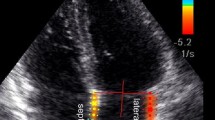Abstract
The purpose of this study was to evaluate the use of respiratory-related ventricular coupling to differentiate patients with constrictive pericarditis (CP) and restrictive cardiomyopathy (RCM). In 18 histologically proven cases of CP, 6 patients with inflammatory pericarditis (IP), 15 RCM patients and 17 normal subjects, real-time cine MRI was performed in the cardiac short-axis (basal half of the ventricles) during operator-guided deep respiration. The images were analyzed for ventricular septal position and shape during early ventricular filling. Early diastolic septal inversion (I) or flattening (F) was found in all CP (I:15,F:3), and in all IP (I:2,F:4), but seldom in normals (F:1) and not in RCM. The septal abnormalities occurred at the onset of inspiration and rapidly disappeared with the next heartbeats. The amount of ventricular coupling was evaluated by quantifying the difference in the maximal septal excursion between inspiration and expiration. This parameter, normalized to the biventricular diameter, was significantly larger in CP (20.0±4.5%, P<0.0001) and IP (14.8±3.2%, P<0.0001) patients than in normals (7.0±2.4%), whereas RCM patients had a trend toward decreased excursion (4.2±1.7%, P=0.11). A cut-off value of 11.8% (mean normals +2 SD) enabled to differentiate CP patients from normals and RCM patients completely. Real-time cine MRI can easily depict increased ventricular coupling, which may be helpful to better differentiate between CP and RCM patients, especially in patients with normal or minimally thickened pericardium. The increase in coupling in IP patients is likely caused by decreased compliance of the inflamed pericardial layers.







Similar content being viewed by others
References
Spodick DH (1997) The Pericardium: a Comprehensive Textbook. M. Dekker, New York, NY, 233,464
Sechtem U, Tscholakoff D, Higgins CB (1986) MRI of the abnormal pericardium. Am J Roentgenol 47:245–252
Talreja DR, Edwards WD, Danielson GK et al (2003) Constrictive pericarditis in 26 patients with histologically normal pericardial thickness. Circulation 108:1852–1857
Hatle LK, Appleton CP, Popp RL (1989) Differentiation of constrictive pericarditis and restrictive cardiomyopathy by Doppler echocardiography. Circulation 79:357–370
Hancock EW (2001) Differential diagnosis of restrictive cardiomyopathy and constrictive pericarditis. Heart 86:343–349
Giorgi B, Mollet NR, Dymarkowski S, Rademakers F, Bogaert J (2003) Assessment of ventricular septal motion in patients clinically suspected of constrictive pericarditis, using magnetic resonance imaging. Radiology 228:417–424
Francone M, Dymarkowski S, Kalantzi M, Bogaert J (2005) Real-time cine MRI of ventricular septal motion. A novel approach to assess ventricular coupling. J Magn Reson Imaging 234:542–547
Guzman PA, Maugham WL, Yin FCP et al (1981) Transseptal pressure gradient with leftward septal displacement during the Mueller manoeuvre in man. Br Heart J 46:657–662
Santamore WP, Bartlett R, Van Buren SJ, Dowd MK, Kutcher MA (1986) Ventricular coupling in constrictive pericarditis. Circulation 74:597–602
Haley JH, Tajik AJ, Danielson GK, Schaff HV, Mulvagh SL, Oh JK (2004) Transient constrictive pericarditis: causes and natural history. J Am Coll Cardiol 43:271–275
Hasuda T, Satoh T, Yamada N et al (1999) A case of constrictive pericarditis with local thickening of the pericardium without manifest ventricular interdependence. Cardiology 92:214–216
Rienmüller R, Gürgan M, Erdman E, Kemkes BM, Kreutzer E, Weinhold C (1993) CT and MR evalution of pericardial constriction: a new diagnostic and therapeutic concept. J Thorac Imaging 8:108–121
Masui T, Finck S, Higgins CB (1992) Constrictive pericarditis and restrictive cardiomyopathy: evaluation with MR imaging. Radiology 182:369–373
Bogaert J, Dymarkowski S, Taylor AM (2005) Pericardial Disease in Clinical Cardiac MRI. Springer, Berlin Heidelberg New York, 294–300
Author information
Authors and Affiliations
Corresponding author
Additional information
M. Francone and M. Kalantzi were supported by the European Commission with a Marie-Curie Fellowship.
Electronic supplementary material
330_2005_9_MOESM1_ESM.avi
(AVI 1152 kb)
330_2005_9_MOESM2_ESM.avi
(AVI 1226 kb)
330_2005_9_MOESM3_ESM.avi
(AVI 1619 kb)
330_2005_9_MOESM4_ESM.avi
(AVI 1153 kb)
330_2005_9_MOESM5_ESM.avi
(AVI 1632 kb)
Rights and permissions
About this article
Cite this article
Francone, M., Dymarkowski, S., Kalantzi, M. et al. Assessment of ventricular coupling with real-time cine MRI and its value to differentiate constrictive pericarditis from restrictive cardiomyopathy. Eur Radiol 16, 944–951 (2006). https://doi.org/10.1007/s00330-005-0009-0
Received:
Revised:
Accepted:
Published:
Issue Date:
DOI: https://doi.org/10.1007/s00330-005-0009-0




